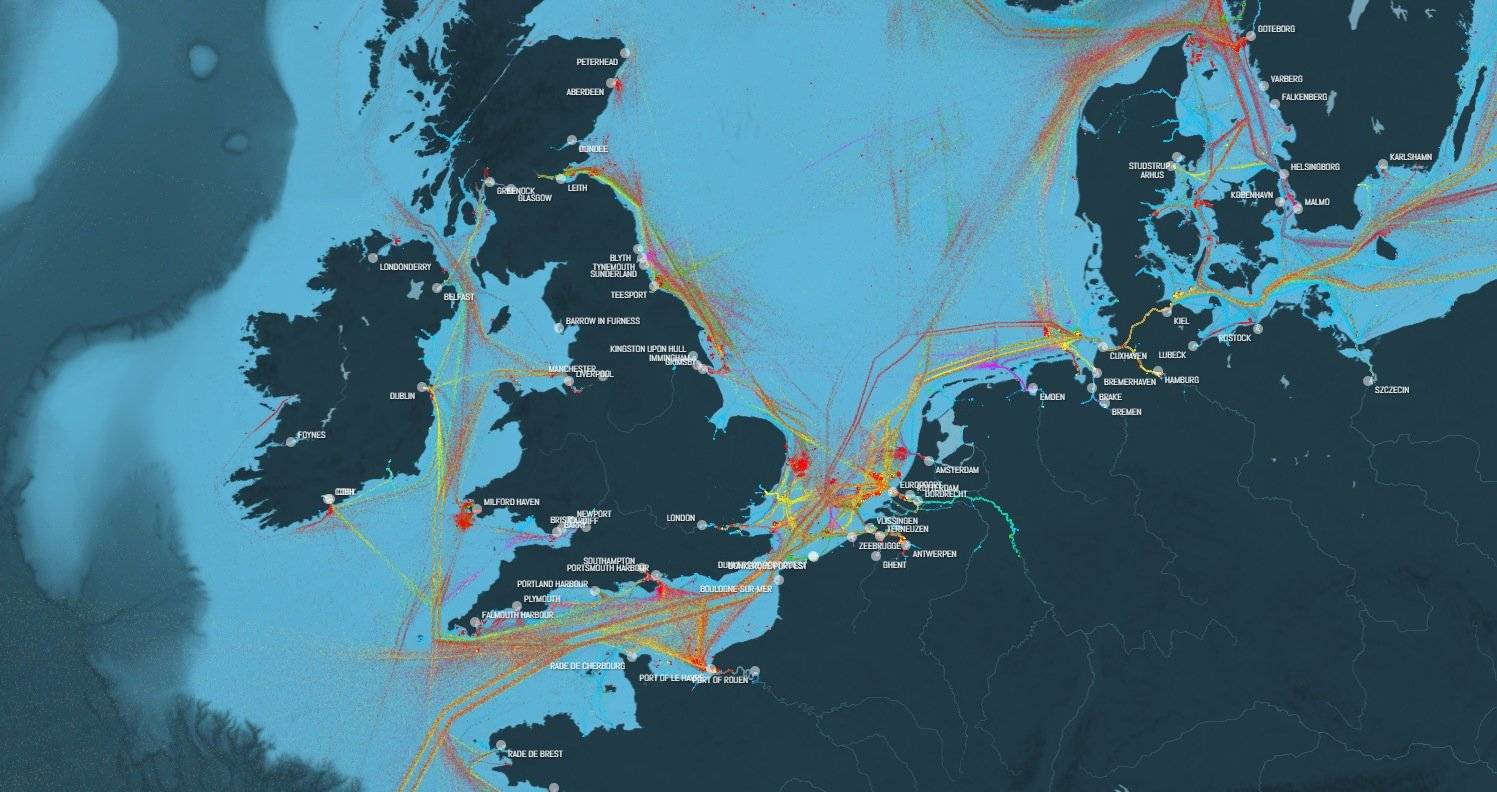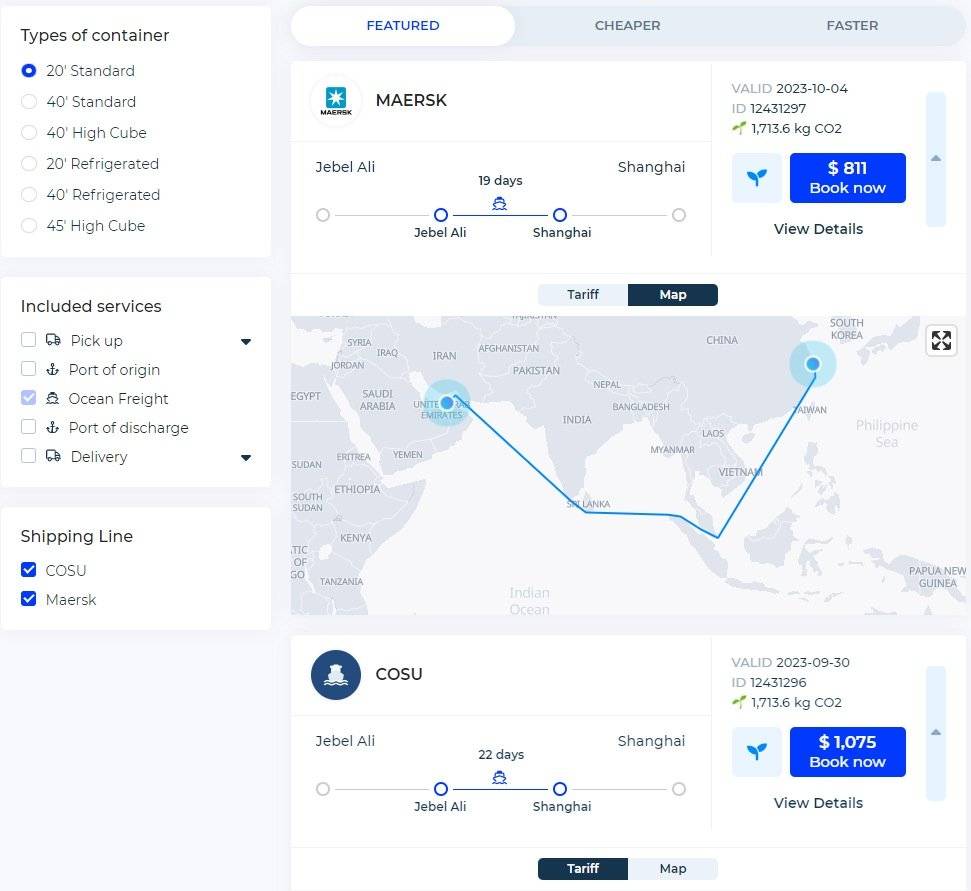Maritime shipping plays a pivotal role in global trade, seamlessly connecting manufacturers, producers, logistics providers and shippers across continents. The heart of this massive network lies in the major shipping routes that facilitate the movement of goods and raw materials. Let's discover the five major international shipping lanes that are the lifelines of global commerce.
English Channel
Recognized as the busiest shipping lane in the world, the English Channel witnesses over 400-500 vessel transits daily. Bridging the North Sea and the Atlantic Ocean, it forms an indispensable link in the global shipping routes, connecting the UK and Europe. Every year, this channel sees the transit of millions of passengers and thousands of containers, transporting essential goods like food, fuel, and manufactured products.

Map source: shipmap.org
The English Channel has its narrowest point at the Strait of Dover (21 mi). This constriction in the channel necessitates a unique navigation approach for vessels. Much like vehicles on a two-lane highway, ships traversing the Strait of Dover are required to move in well-defined, orderly lanes.
Malacca Strait
Positioned between Indonesia, Malaysia, and Singapore, the Malacca Strait stands as a prominent name in maritime routes. For the whole of 2022, it recorded over 80,000 vessel transits. This 550-mile-long shipping channel is the primary trade route connecting Asia and Europe. Goods from nations like China, Japan, and South Korea traverse this strait en route to the Middle East and Europe. Additionally, it's a significant passage for oil shipments, with tankers transporting crude oil from the Middle East to various Asian destinations and beyond. Around 40% of the world's trade goes through this narrow area every year.

Map source: shipmap.org
In the screenshot below, you'll find an example of the transportation route from the Port of Jebel Ali to the Port of Shanghai, demonstrating the high demand through the Malacca Strait. As you can see, there are a large number of freight forwarders, which allows you to choose from numerous offers. Using the Logistics Explorer tool, you can choose the option that best suits you in terms of price and delivery time. If you don't find the right one, you can use the Quick Request form to find even more freight rates.

Strait of Hormuz
Located between Iran and Oman, the Strait of Hormuz is a pivotal point in maritime shipping. It's the primary maritime route for Middle Eastern oil, with over 20 million barrels of oil navigating through daily. In 2022, this strait witnessed over 20,000 vessel transits, ranking it as a top contender in the list of busiest shipping channels globally.

Map source: shipmap.org
From the Strait of Hormuz, ships head in all directions, providing fossil fuels to Asia, Europe, and America. If you have cargo that needs to be transported through this strait to any of the destinations, we recommend filling out the Request a Quote form. Enquire from leading freight forwarders and shipping lines and get the best possible rates.
Suez Canal
The Suez Canal, a vital name in international shipping lanes, links the Mediterranean and the Red Sea. In 2020, it saw over 18,000 vessel transits. This canal is crucial for goods moving between Europe and Asia, reducing the journey duration by several weeks compared to the alternative route around Africa's southern tip. Moreover, it's a key conduit for oil tankers transporting crude from the Middle East to Europe.

Map source: shipmap.org
Serving as a vital artery, it facilitates a significant portion of the world's maritime trade. However, its strategic importance is a double-edged sword. The canal's narrow confines and the massive amount of vessels that rely on it also make it a notable bottleneck in world shipping. This vulnerability was starkly highlighted in 2019 when an accident involving a large vessel temporarily blocked the canal, causing significant disruptions in global supply chains. If your shipment has a strict time limitation, you must be sure that passing Suez Canal wouldn’t take too much time. Use the SeaRates Distance & Time tool to estimate the time of your shipments.

Panama Canal
Connecting the Pacific and Atlantic Oceans, the Panama Canal is a significant name in global shipping routes. With over 14,000 vessel transits recorded in 2020, it plays a crucial role in maritime trade. This canal is essential for goods moving between the east and west coasts of the Americas. It's also a significant route for container ships traveling to Asia from the US East Coast, offering a much shorter journey than the route around South America's southern tip.

Map source: shipmap.org
Annually, close to 15,000 vessels navigate the Panama Canal, but due to the canal's narrow locks, which operate using water from an elevated lake, only a limited number of ships can pass through daily, leading some to anchor for weeks awaiting their turn. To accommodate larger, next-generation container ships, the canal is currently expanding with additional sets of locks on both the Atlantic and Pacific sides.
Conclusion
These maritime routes are the backbone of global trade, ensuring the constant flow of cargoes. Understanding their significance is crucial for everyone who is involved in logistics and the global supply chain. To find the best freight quotes among hundreds of possible options on these busy routes, we recommend using SeaRates IT tools for logistics.
Contact our team at [email protected] to find out more about integrating IT solutions into your transportation operations.

